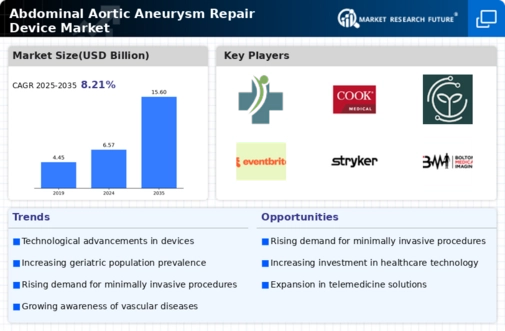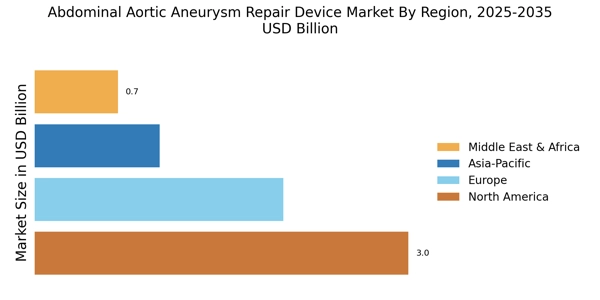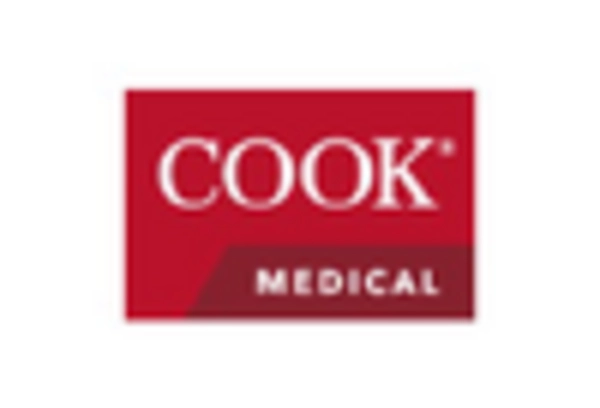Rising Incidence of Aneurysms
The increasing prevalence of abdominal aortic aneurysms (AAAs) is a primary driver for the Abdominal Aortic Aneurysm Repair Device Market. Factors such as aging populations and lifestyle-related health issues contribute to this rise. According to recent data, the incidence of AAAs is projected to increase, particularly among individuals aged 65 and older. This demographic shift necessitates advanced repair devices to manage the growing patient population effectively. As healthcare systems adapt to these changes, the demand for innovative repair solutions is likely to surge, thereby propelling market growth. Furthermore, the awareness surrounding AAA screening and treatment options is enhancing, which may lead to earlier diagnosis and intervention, further stimulating the market for repair devices.
Increasing Healthcare Expenditure
Rising healthcare expenditure across various regions is a significant driver for the Abdominal Aortic Aneurysm Repair Device Market. As governments and private sectors allocate more resources to healthcare, there is a corresponding increase in funding for advanced medical technologies. This financial support enables hospitals and clinics to invest in state-of-the-art repair devices, enhancing their capabilities to treat AAAs effectively. Market analysis indicates that countries with higher healthcare spending are likely to see a corresponding rise in the adoption of innovative repair solutions. Furthermore, as healthcare systems strive to improve patient outcomes and reduce long-term costs associated with AAA complications, the demand for effective repair devices is expected to grow. This trend may lead to increased competition among manufacturers, driving further advancements in device technology.
Regulatory Support and Approval Processes
The evolving regulatory landscape is playing a crucial role in shaping the Abdominal Aortic Aneurysm Repair Device Market. Regulatory bodies are increasingly streamlining approval processes for innovative medical devices, which can expedite the introduction of new products to the market. This supportive environment encourages manufacturers to invest in research and development, fostering innovation in device design and functionality. As regulatory frameworks adapt to accommodate advancements in technology, the market is likely to benefit from a wider array of repair devices that meet stringent safety and efficacy standards. Additionally, the emphasis on post-market surveillance and real-world evidence is expected to enhance the credibility of new devices, further driving their adoption in clinical settings. This regulatory support may ultimately lead to a more dynamic and competitive market landscape.
Technological Innovations in Device Design
Technological advancements in the design and functionality of abdominal aortic aneurysm repair devices are significantly influencing the Abdominal Aortic Aneurysm Repair Device Market. Innovations such as the development of endovascular stent grafts and improved imaging techniques are enhancing the efficacy and safety of procedures. These devices are becoming increasingly sophisticated, offering features like customizable sizing and enhanced durability. The market is witnessing a shift towards devices that minimize complications and improve patient outcomes. As a result, healthcare providers are more inclined to adopt these advanced solutions, which could lead to a substantial increase in market share for manufacturers who prioritize research and development. The integration of digital technologies, such as telemedicine and remote monitoring, is also expected to play a crucial role in the future of device management.
Growing Preference for Minimally Invasive Techniques
The trend towards minimally invasive surgical techniques is reshaping the Abdominal Aortic Aneurysm Repair Device Market. Patients and healthcare providers alike are increasingly favoring procedures that reduce recovery time and minimize surgical trauma. Endovascular aneurysm repair (EVAR) has gained traction due to its less invasive nature compared to traditional open surgery. This shift is supported by clinical evidence indicating that minimally invasive approaches lead to lower complication rates and shorter hospital stays. As a result, the demand for devices that facilitate these procedures is on the rise. Market data suggests that the adoption of EVAR is expected to grow, further driving the need for innovative repair devices that align with this surgical trend. Consequently, manufacturers are likely to focus on developing products that cater to this evolving preference.


















Leave a Comment